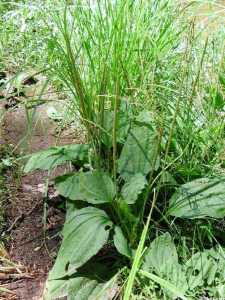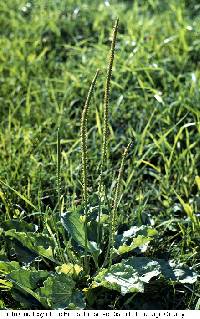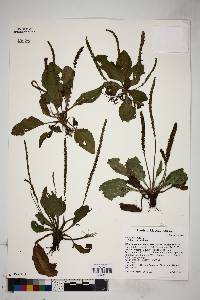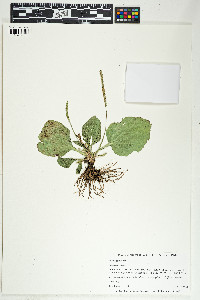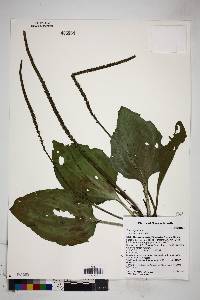Search
View the original page version
Plantago major
|
|
|
|
Family: Plantaginaceae
common plantain
[Plantago halophila E.P. Bicknell, morePlantago intermedia Gilib., Plantago major subsp. intermedia (DC.) Lange, Plantago major var. asiatica (L.) Decne., Plantago major var. intermedia (DC.) Pilg., Plantago major var. pachyphylla Pilg., Plantago major var. pilgeri Domin, Plantago major var. scopulorum Fr. & Broberg] |
Plant: Perennial herb; to 42 cm tall Leaves: petiolate; blades broadly ovate, 3.5-15 cm long, 2-9 cm wide, attenuate at base, acute at apex, sparsely pubescent, becoming glabrate, distinctly 3 (-5)-veined, the margins with a few shallow lobes near base INFLORESCENCE: pedunculate, scapose; PEDUNCLES 4-20 cm long, sparsely pubescent to glabrous, sometimes appearing ridged to four-sided. SPIKES 3-24 cm long, interrupted near base; bracts broadly ovate, 1.5-4.5 mm long, broad scarious-margined; midvein glabrous Flowers: perfect; sepals broadly ovate to elliptic, 1.2-2.3 mm long, broadly scarious-margined, midvein glabrous; corolla lobes spreading or reflexed, ovate, 0.7-1.5 mm long; stamens 4 Fruit: capsules, breaking well below middle; SEEDS 6-many, irregular in shape, ca. 1.0 mm long, ca. 0.5 mm wide, olive-green to dark brown, the outer surface furrowed Misc: weed of wet areas; 650-2500 m (2200-8200 ft.); May-Oct Notes: Bracts ovate and 2-4mm long.Only one terminal spike. References: Kearney & Peebles; Arizona Flora. McDougall; Seed plants of Northern Arizona. ASU specimans. Huisinga, Kristin D. and Tina J. Ayers. 1999. Plantaginaceae. Ariz. - Nev. Acad. Sci. 32(1). Perennial herb with fibrous roots flowering stem 5 - 25 cm tall Leaves: basal, thick-stalked, 4 - 18 cm long, 1.5 - 11 cm wide, broadly elliptic to broadly egg-shaped with an abruptly contracted base, more or less parallel-veined, strongly veined, sometimes irregularly toothed, thick, sometimes minutely hairy. Inflorescence: a narrow, dense spike of many flowers, arising from a leafless stalk (scape), 5 - 30 cm long, less than 1 cm wide. Flowers: stalkless or nearly stalkless, whitish, subtended by broadly egg-shaped bracts, not fragrant. Bracts 2 - 4 mm long, prominently keeled. Stamens four, exserted, alternate with corolla lobes. Style one. Sepals: four, green, 1.5 - 2 mm long, rounded to egg-shaped, scarious-margined (dry, thin, and membranous), with a rounded keel. Fruit: a dehiscent capsule (circumscissile), brown to purplish, 2.5 - 4 mm long, diamond- to egg-shaped. Seeds six to thirty, about 1 mm long, wrinkled, plump. Corolla: four-lobed, whitish, less than 1 mm long, scarious (dry, thin, membranous). Lobes becoming reflexed, about 1 mm long. Similar species: Plantago rugelii is similar but has purplish leafstalks and longer sepals (2.5 - 3 mm). Plantago media is also similar but has fragrant flowers and flat seeds. Flowering: June to mid-September Habitat and ecology: Introduced from Eurasia. Frequent in waste ground and packed soil. Occurence in the Chicago region: non-native Etymology: Plantago comes from the Latin word planta, meaning footprint. Major means larger. Author: The Morton Arboretum Fibrous-rooted perennial from a short, stout, erect caudex, glabrous or rather inconspicuously hairy, especially below; lvs with broadly elliptic to broadly ovate or cordate- ovate blade ±abruptly contracted to the well defined petiole, the blade entire or irregularly toothed, mostly 4-18 נ1.5-11 cm, 1.3-2(-3) times as long as wide, strongly 3-several-nerved, the nerves diverging at the base of the blade, ±parallel to the margin; petiole only seldom anthocyanic at base; scapes 5-25 cm; spikes dense but narrow, less than 1 cm thick, commonly 5-30 cm long, essentially glabrous; bracts broad, ovate- obtuse, mostly 2-4 mm, with a prominent, acute keel and thin margins; sep ovate, obtuse, the rounded keel about as wide as the scarious margins; cor-lobes ca 1 mm or less, reflexed after anthesis; stamens 4, exsert; fr rhombic-ovoid, 2.5-4 mm, circumscissile near or a little below the middle; seeds 6-30, 1 mm, strongly reticulate; 2n=12, 24. Native of Eurasia and probably also parts of N. Amer., naturalized throughout the U.S. and s. Can. in lawns, roadsides, and waste places. (P. asiatica) Gleason, Henry A. & Cronquist, Arthur J. 1991. Manual of vascular plants of northeastern United States and adjacent Canada. lxxv + 910 pp. ©The New York Botanical Garden. All rights reserved. Used by permission. Huisinga and Ayers 1999, Kearney and Peebles 1969, Correll and Johnston 1970 Duration: Perennial Nativity: Non-Native Lifeform: Forb/Herb General: Acaulescent perennial herb to 42 cm tall. Growth form is a basal rosette of petioled leaves with multiple spicate inflorescences, taller than the leaves, ascending from within the rosette. Leaves: Petiolate with broadly ovate blades, up to 30 cm long, including the petiole; blades thick and distinctly 3-5 veined, sparsely pubescent, becoming glabrate, margins with shallow lobes near base. Flowers: Pedunculate spikes 3-24 cm long, interrupted near base; peduncle 4-20 cm long, sparsely pubescent to glabrous, appearing ridged or four-sided; flowers perfect, each subtended by a bract; bracts broadly ovate, 1.5-4.5 mm long, broadly scarious-margined with a glabrous midvein; sepals 4, broadly ovate to elliptic, 1-2 mm long, broadly scarious margined with a glabrous midvein; corolla 4-lobed, lobes spreading or reflexed, ovate, about 1 mm long, whitish and scarious; 4 stamens. Fruits: Capsule ovoid, breaks below middle, contains 6-many irregularly shaped seeds. Ecology: Weed of wet areas from 2,000-8,500 ft (610-2591 m); flowers May-October. Distribution: Native to Eurasia and naturalized throughout the world. In North America it is especially common in the Rocky Mountains and the middle to high elevations of the Southwest. Notes: Easily distinguished by its basal cluster of broadly ovate leaves and its habitat of disturbed yet moist areas such as lawns and floodplains; also diagnostic are the broadly ovate and entire bracts. Ethnobotany: Used for pain relief, rheumatism and swellings, as blood medicine, leaves used as a poultice, decoction taken for coughs, for stomach problems, and as a laxative. Many, many other uses by other non-regional tribes. Etymology: Plantago translates to foot-sole in reference to leaf habit on ground, major means larger, or greater. Synonyms: Many, see Tropicos Editor: SBuckley, 2010, AHazelton 2015 |


